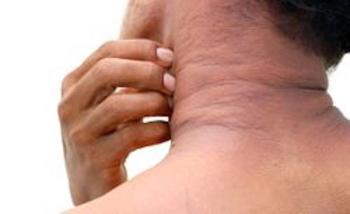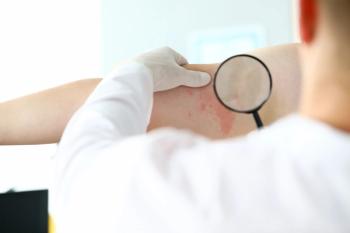
Atopic Dermatitis
Latest News

Latest Videos
CME Content
More News

A digitally delivered targeted intervention of symptom and trigger education, treatment reminders, lifestyle coaching, and healthy lifestyle support demonstrated significant improvements in treatment adherence and related clinical outcomes among Icelandic patients with atopic dermatitis.

Patients with atopic dermatitis reported that exposure to corticosteroid treatment throughout their lifetime put them at a risk for negative outcomes.

Jason Ezra Hawkes, MD, MS, FAAD, board-certified dermatologist and associate professor of dermatology at the University of California Davis in Sacramento, discussed recent advancements in immunotherapy for atopic dermatitis and what unmet needs persist to address uptake issues and patient-specific care needs.

Children who lived in apartments or newer buildings were also found to have an increased risk of atopic dermatitis later in life.

Significant alterations were observed in lipid levels and other skin biomarkers for infants who developed atopic dermatitis (AD) vs controls, with phytosphingosine associated with the highest AD prediction accuracy.

Jason Ezra Hawkes, MD, MS, FAAD, board-certified dermatologist and associate professor of dermatology at the University of California Davis in Sacramento, spoke on the importance of shared decision-making in deciding which biologic would best alleviate disease burden in patients with moderate to severe atopic dermatitis.

Early initiation of daily specialized emollient use until 2 months was associated with a reduced incidence of atopic dermatitis development among high-risk infants.

Significantly more patients given ruxolitinib cream vs vehicle demonstrated rapid improvements in itch that were sustained over time.

Jason Ezra Hawkes, MD, MS, FAAD, board-certified dermatologist and associate professor of dermatology at the University of California Davis in Sacramento, spoke on diagnostic challenges for atopic dermatitis and tips for clinicians in screening for the condition.

Pediatric patients who developed atopic dermatitis (AD) before 2 years of age had an increased risk of neurodevelopmental dysfunction, including gross and fine motor skills, at 6 years old.

Patients with atopic dermatitis (AD) were not found to be at greater risk of venous thromboembolism, regardless of Janus kinase inhibitor use, according to this new meta-analysis.

Jason Ezra Hawkes, MD, MS, FAAD, board-certified dermatologist and associate professor of dermatology at the University of California Davis in Sacramento, explained the utility of type 2 inflammation pathways and the microbiome in understanding the immune dysregulation associated with atopic dermatitis (AD).

Findings of a meta-analysis show that use of dietary elimination had a minimal effect on the severity of atopic dermatitis and may increase the risk of developing immunoglobulin E–mediated food allergy.

Investigator Global Assessment score of very severe atopic dermatitis (AD) was associated with dupilumab discontinuation due to adverse effects, although generally adequate 1-, 2-, and 3-year drug survival rates were also observed.

Most patients with atopic dermatitis had flunctuating levels of depressive symptoms, with having public or no insurance, more severe itch, and skin pain cited as additional predictors of adverse mental health outcomes.

European adult patients with atopic dermatitis most valued therapies that had rapid onset, oral administration, and were able to be paused—even at the expense of reduced efficacy.

Substantially impaired quality of life was shown in patients with photoaggravated atopic dermatitis, with phototesting cited as an effective diagnostic approach in promoting personalized care.

Systemic corticosteroids were more commonly prescribed vs other systemic drug options in Germany for patients with atopic dermatitis (AD) despite their unfavorable risk-benefit profile, with a substantial economic burden cited among these populations.

Elaine Siegfried, MD, professor of pediatrics and dermatology, Saint Louis University Health Sciences Center, speaks on step edits and other barriers limiting access to biologic, topical, and other medications for the treatment of atopic dermatitis (AD).

Increased atopic dermatitis severity in pediatric patients was associated with a greater physical, emotional, social, and economic impact on families.

The significant quality of life burden associated with symptoms of itching and/or skin pain in patients with atopic dermatitis (AD) may warrant alternate approaches to address unmet needs.

A majority of patients with moderate or severe atopic dermatitis (AD) reported moderate-to-high negative impacts on quality of life.

Elaine Siegfried, MD, professor of pediatrics and dermatology, Saint Louis University Health Sciences Center, addresses the comorbidity profile associated with atopic dermatitis and the utility of disease-modifying drugs to reduce risk of comorbid conditions.

Patients from this diverse cohort experienced improvements in atopic dermatitis (AD) clinical scores after a year or more of treatment with dupilumab.

Robert Sidbury, MD, MPH, Chief, Division of Dermatology, Seattle Children's Hospital, speaks on strategies that clinicians can employ to promote adherence of topical and oral medications in pediatric patients with atopic dermatitis.

















































